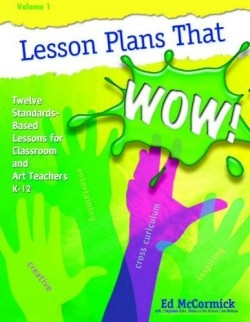Lesson Plans That Wow!
12 Standards-Based Lessons for the Classroom and Art Teacher K-12
The best teachers are the ones who inspire their students. This is no secret, but sometimes in the midst of standardized testing, enlarged class sizes, metal detectors, and other daily distractions, schools forget that students learn best when they’re excited about what they are supposed to be learning. In Lesson Plans That Wow, authors Ed McCormick, Stephanie Dyke, and Jon Weiman provide twelve art projects which are intended to influence learning across the curriculum. Plus, kids get messy doing these projects, and kids love to get messy in a classroom where so much of the work feels like just that: work.
The lessons in the book center around making molds and casting different objects, such as fossils, faces, food, and hands. McCormick also gives instructions for encapsulating an ocean scene to demonstrate how amber can trap organisms and preserve them for thousands of years. A lesson plan for grades K-4 shows how to make stamp-like castings of imaginary animal feet which can then be used to make tracks with paint and paper. Any student will enjoy making trilobite or chicken bone fossils.
McCormick and his two co-authors have taught art classes and workshops across the country and are well-practiced in communicating with both teachers and students. Each lesson plan offers “Tips For Teachers” and a section on teacher preparation to help make the most out of valuable classroom time. According to the book’s introduction, these lesson plans have been tested by classroom teachers across the country and a common response was, “Wow!” Thus, the title of the book was born.
The required materials may be unfamiliar to those teachers who do not normally focus on art, but a quick Internet search reveals they are readily available from McCormick’s own art supply company. A practice run without an audience may be beneficial for teachers who haven’t handled materials like CastRite casting stone or MoldGel SilFree Regular Set before.
The lessons outlined in this book are fairly clear—each is accompanied by a list of materials, suggested resources, a vocabulary list, directions, and plenty of clarifying photographs. The plans would have benefited from closer attention to structure; while some of the instructions are related in paragraph form, others are numbered and still others are written with bullet points. Consistency would have lent the book more accessibility. Occasional grammatical and copy editing errors are distracting, though they do not detract from the meaning of the text.
McCormick and his team should be applauded for injecting creativity into the classroom. In the current culture of school competition, a little fun goes a long way in engaging students with the world around them.
Reviewed by
Andi Diehn
Disclosure: This article is not an endorsement, but a review. The publisher of this book provided free copies of the book and paid a small fee to have their book reviewed by a professional reviewer. Foreword Reviews and Clarion Reviews make no guarantee that the publisher will receive a positive review. Foreword Magazine, Inc. is disclosing this in accordance with the Federal Trade Commission’s 16 CFR, Part 255.

